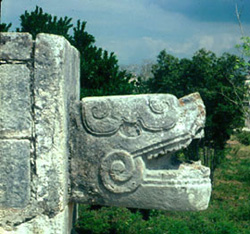
|
|
|
Founding of Chichén Itzá As with many aspects of Mayan history, the history of Chichén Itzá is obscure: Written records are scarce. In the historical records that do exist, dates that were several years apart were often given the same name, due to the organization of the Mayan calendar. Most sources agree that from approximately AD 550 to AD 800, Chichén Itzá existed mainly as a ceremonial center for the Maya. The area was then largely abandoned for about a hundred years (why, no one is certain), to be resettled around AD 900. Shortly before AD 1000, it was invaded by the Toltecs, a people from the north.  The Toltecs had settled at Tula, near modern-day Mexico City, around AD 900 under the rule of a king named Topiltzin. Topiltzin also took the name of Quetzalcoatl, or “Feathered Serpent,” the name of an Aztec god. A rival warrior faction forced Topiltzin Quetzalcoatl and his followers out of Tula around AD 987. Mayan historical sources mention that in the period that ended in AD 987, a man who called himself Kukulkán arrived in Chichén Itzá from the west (
Kukul
means “feathered” and
kan
means “serpent”). A strong case has been made that Topiltzin Quetzalcoatl and Kukulkán were most likely the same person, and that he brought the Toltec beliefs and practices to Chichén Itzá, including the practice of human sacrifice. The Toltecs were somewhat open to new ideas, however, incorporating some beliefs held by the Maya already at Chichén Itzá.
The Toltecs had settled at Tula, near modern-day Mexico City, around AD 900 under the rule of a king named Topiltzin. Topiltzin also took the name of Quetzalcoatl, or “Feathered Serpent,” the name of an Aztec god. A rival warrior faction forced Topiltzin Quetzalcoatl and his followers out of Tula around AD 987. Mayan historical sources mention that in the period that ended in AD 987, a man who called himself Kukulkán arrived in Chichén Itzá from the west (
Kukul
means “feathered” and
kan
means “serpent”). A strong case has been made that Topiltzin Quetzalcoatl and Kukulkán were most likely the same person, and that he brought the Toltec beliefs and practices to Chichén Itzá, including the practice of human sacrifice. The Toltecs were somewhat open to new ideas, however, incorporating some beliefs held by the Maya already at Chichén Itzá.
|